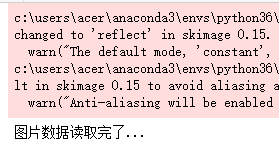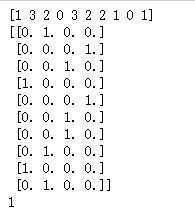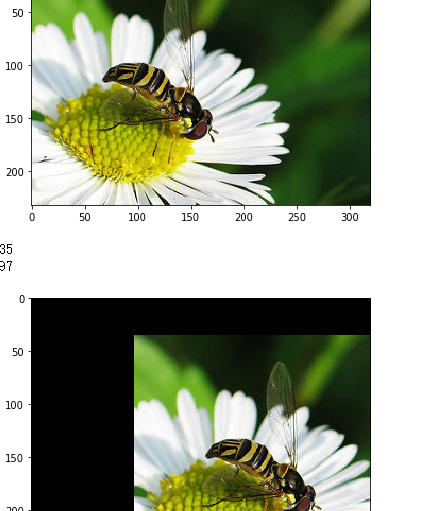吴裕雄 python神经网络 花朵图片识别(9)
import os
import numpy as np
import matplotlib.pyplot as plt
from PIL import Image, ImageChops
from skimage import color,data,transform,io
#获取所有数据文件夹名称
fileList = os.listdir("F:\\data\\flowers")
trainDataList = []
trianLabel = []
testDataList = []
testLabel = []
for j in range(len(fileList)):
data = os.listdir("F:\\data\\flowers\\"+fileList[j])
testNum = int(len(data)*0.25)
while(testNum>0):
np.random.shuffle(data)
testNum -= 1
trainData = np.array(data[:-(int(len(data)*0.25))])
testData = np.array(data[-(int(len(data)*0.25)):])
for i in range(len(trainData)):
if(trainData[i][-3:]=="jpg"):
image = io.imread("F:\\data\\flowers\\"+fileList[j]+"\\"+trainData[i])
image=transform.resize(image,(64,64))
trainDataList.append(image)
trianLabel.append(int(j))
angle = np.random.randint(-90,90)
image =transform.rotate(image, angle)
image=transform.resize(image,(64,64))
trainDataList.append(image)
trianLabel.append(int(j))
for i in range(len(testData)):
if(testData[i][-3:]=="jpg"):
image = io.imread("F:\\data\\flowers\\"+fileList[j]+"\\"+testData[i])
image=transform.resize(image,(64,64))
testDataList.append(image)
testLabel.append(int(j))
print("图片数据读取完了...")

print(np.shape(trainDataList))
print(np.shape(trianLabel))
print(np.shape(testDataList))
print(np.shape(testLabel))

print("正在写磁盘...")
np.save("G:\\trainDataList",trainDataList)
np.save("G:\\trianLabel",trianLabel)
np.save("G:\\testDataList",testDataList)
np.save("G:\\testLabel",testLabel)
print("数据处理完了...")

import numpy as np
from keras.utils import to_categorical
trainLabel = np.load("G:\\trianLabel.npy")
testLabel = np.load("G:\\testLabel.npy")
trainLabel_encoded = to_categorical(trainLabel)
testLabel_encoded = to_categorical(testLabel)
np.save("G:\\trianLabel",trainLabel_encoded)
np.save("G:\\testLabel",testLabel_encoded)
print("转码类别写盘完了...")

import random
import numpy as np
trainDataList = np.load("G:\\trainDataList.npy")
trianLabel = np.load("G:\\trianLabel.npy")
print("数据加载完了...")
trainIndex = [i for i in range(len(trianLabel))]
random.shuffle(trainIndex)
trainData = []
trainClass = []
for i in range(len(trainIndex)):
trainData.append(trainDataList[trainIndex[i]])
trainClass.append(trianLabel[trainIndex[i]])
print("训练数据shuffle完了...")
np.save("G:\\trainDataList",trainData)
np.save("G:\\trianLabel",trainClass)
print("训练数据写盘完毕...")

import random
import numpy as np
testDataList = np.load("G:\\testDataList.npy")
testLabel = np.load("G:\\testLabel.npy")
testIndex = [i for i in range(len(testLabel))]
random.shuffle(testIndex)
testData = []
testClass = []
for i in range(len(testIndex)):
testData.append(testDataList[testIndex[i]])
testClass.append(testLabel[testIndex[i]])
print("测试数据shuffle完了...")
np.save("G:\\testDataList",testData)
np.save("G:\\testLabel",testClass)
print("测试数据写盘完毕...")

# coding: utf-8
import tensorflow as tf
from random import shuffle
INPUT_NODE = 64*64
OUT_NODE = 5
IMAGE_SIZE = 64
NUM_CHANNELS = 3
NUM_LABELS = 5
#第一层卷积层的尺寸和深度
CONV1_DEEP = 16
CONV1_SIZE = 5
#第二层卷积层的尺寸和深度
CONV2_DEEP = 32
CONV2_SIZE = 5
#全连接层的节点数
FC_SIZE = 512
def inference(input_tensor, train, regularizer):
#卷积
with tf.variable_scope('layer1-conv1'):
conv1_weights = tf.Variable(tf.random_normal([CONV1_SIZE,CONV1_SIZE,NUM_CHANNELS,CONV1_DEEP],stddev=0.1),name='weight')
tf.summary.histogram('convLayer1/weights1', conv1_weights)
conv1_biases = tf.Variable(tf.Variable(tf.random_normal([CONV1_DEEP])),name="bias")
tf.summary.histogram('convLayer1/bias1', conv1_biases)
conv1 = tf.nn.conv2d(input_tensor,conv1_weights,strides=[1,1,1,1],padding='SAME')
tf.summary.histogram('convLayer1/conv1', conv1)
relu1 = tf.nn.relu(tf.nn.bias_add(conv1,conv1_biases))
tf.summary.histogram('ConvLayer1/relu1', relu1)
#池化
with tf.variable_scope('layer2-pool1'):
pool1 = tf.nn.max_pool(relu1,ksize=[1,2,2,1],strides=[1,2,2,1],padding='SAME')
tf.summary.histogram('ConvLayer1/pool1', pool1)
#卷积
with tf.variable_scope('layer3-conv2'):
conv2_weights = tf.Variable(tf.random_normal([CONV2_SIZE,CONV2_SIZE,CONV1_DEEP,CONV2_DEEP],stddev=0.1),name='weight')
tf.summary.histogram('convLayer2/weights2', conv2_weights)
conv2_biases = tf.Variable(tf.random_normal([CONV2_DEEP]),name="bias")
tf.summary.histogram('convLayer2/bias2', conv2_biases)
#卷积向前学习
conv2 = tf.nn.conv2d(pool1,conv2_weights,strides=[1,1,1,1],padding='SAME')
tf.summary.histogram('convLayer2/conv2', conv2)
relu2 = tf.nn.relu(tf.nn.bias_add(conv2,conv2_biases))
tf.summary.histogram('ConvLayer2/relu2', relu2)
#池化
with tf.variable_scope('layer4-pool2'):
pool2 = tf.nn.max_pool(relu2,ksize=[1,2,2,1],strides=[1,2,2,1],padding='SAME')
tf.summary.histogram('ConvLayer2/pool2', pool2)
#变型
pool_shape = pool2.get_shape().as_list()
#计算最后一次池化后对象的体积(数据个数\节点数\像素个数)
nodes = pool_shape[1]*pool_shape[2]*pool_shape[3]
#根据上面的nodes再次把最后池化的结果pool2变为batch行nodes列的数据
reshaped = tf.reshape(pool2,[-1,nodes])
#全连接层
with tf.variable_scope('layer5-fc1'):
fc1_weights = tf.Variable(tf.random_normal([nodes,FC_SIZE],stddev=0.1),name='weight')
if(regularizer != None):
tf.add_to_collection('losses',tf.contrib.layers.l2_regularizer(0.03)(fc1_weights))
fc1_biases = tf.Variable(tf.random_normal([FC_SIZE]),name="bias")
#预测
fc1 = tf.nn.relu(tf.matmul(reshaped,fc1_weights)+fc1_biases)
if(train):
fc1 = tf.nn.dropout(fc1,0.5)
#全连接层
with tf.variable_scope('layer6-fc2'):
fc2_weights = tf.Variable(tf.random_normal([FC_SIZE,64],stddev=0.1),name="weight")
if(regularizer != None):
tf.add_to_collection('losses',tf.contrib.layers.l2_regularizer(0.03)(fc2_weights))
fc2_biases = tf.Variable(tf.random_normal([64]),name="bias")
#预测
fc2 = tf.nn.relu(tf.matmul(fc1,fc2_weights)+fc2_biases)
if(train):
fc2 = tf.nn.dropout(fc2,0.5)
#全连接层
with tf.variable_scope('layer7-fc3'):
fc3_weights = tf.Variable(tf.random_normal([64,NUM_LABELS],stddev=0.1),name="weight")
if(regularizer != None):
tf.add_to_collection('losses',tf.contrib.layers.l2_regularizer(0.03)(fc3_weights))
fc3_biases = tf.Variable(tf.random_normal([NUM_LABELS]),name="bias")
#预测
logit = tf.matmul(fc2,fc3_weights)+fc3_biases
return logit
import time
import keras
import numpy as np
from keras.utils import np_utils
X = np.load("G:\\trainDataList.npy")
Y = np.load("G:\\trianLabel.npy")
print(np.shape(X))
print(np.shape(Y))
print(np.shape(testData))
print(np.shape(testLabel))
batch_size = 10
n_classes=5
epochs=16#循环次数
learning_rate=1e-4
batch_num=int(np.shape(X)[0]/batch_size)
dropout=0.75
x=tf.placeholder(tf.float32,[None,64,64,3])
y=tf.placeholder(tf.float32,[None,n_classes])
# keep_prob = tf.placeholder(tf.float32)
#加载测试数据集
test_X = np.load("G:\\testDataList.npy")
test_Y = np.load("G:\\testLabel.npy")
back = 64
ro = int(len(test_X)/back)
#调用神经网络方法
pred=inference(x,1,"regularizer")
cost=tf.reduce_mean(tf.nn.softmax_cross_entropy_with_logits(logits=pred,labels=y))
# 三种优化方法选择一个就可以
optimizer=tf.train.AdamOptimizer(1e-4).minimize(cost)
# train_step = tf.train.GradientDescentOptimizer(0.001).minimize(cost)
# train_step = tf.train.MomentumOptimizer(0.001,0.9).minimize(cost)
#将预测label与真实比较
correct_pred=tf.equal(tf.argmax(pred,1),tf.argmax(y,1))
#计算准确率
accuracy=tf.reduce_mean(tf.cast(correct_pred,tf.float32))
merged=tf.summary.merge_all()
#将tensorflow变量实例化
init=tf.global_variables_initializer()
start_time = time.time()
with tf.Session() as sess:
sess.run(init)
#保存tensorflow参数可视化文件
writer=tf.summary.FileWriter('F:/Flower_graph', sess.graph)
for i in range(epochs):
for j in range(batch_num):
offset = (j * batch_size) % (Y.shape[0] - batch_size)
# 准备数据
batch_data = X[offset:(offset + batch_size), :]
batch_labels = Y[offset:(offset + batch_size), :]
sess.run(optimizer, feed_dict={x:batch_data,y:batch_labels})
result=sess.run(merged, feed_dict={x:batch_data,y:batch_labels})
writer.add_summary(result, i)
loss,acc = sess.run([cost,accuracy],feed_dict={x:batch_data,y:batch_labels})
print("Epoch:", '%04d' % (i+1),"cost=", "{:.9f}".format(loss),"Training accuracy","{:.5f}".format(acc*100))
writer.close()
print("########################训练结束,下面开始测试###################")
for i in range(ro):
s = i*back
e = s+back
test_accuracy = sess.run(accuracy,feed_dict={x:test_X[s:e],y:test_Y[s:e]})
print("step:%d test accuracy = %.4f%%" % (i,test_accuracy*100))
print("Final test accuracy = %.4f%%" % (test_accuracy*100))
end_time = time.time()
print('Times:',(end_time-start_time))
print('Optimization Completed')

........................................

import os
import numpy as np
from scipy import ndimage
from skimage import color,data,transform,io
move=np.arange(-3,3,1)
moveIndex = np.random.randint(len(move))
lightStrong=np.arange(0.01,3,0.1)
lightStrongIndex = np.random.randint(len(lightStrong))
moveImage=ndimage.shift(transImageGray,move[moveIndex],cval=lightStrong[lightStrongIndex])
moveImage[moveImage>1.0]=1.0
from numpy import array
from numpy import argmax
from keras.utils import to_categorical
from sklearn.preprocessing import LabelEncoder
#对数值
data=[1, 3, 2, 0, 3, 2, 2, 1, 0, 1]
data=array(data)
print(data)
encoded = to_categorical(data)
print(encoded)
inverted = argmax(encoded[0])
print(inverted)

import numpy as np
from numpy import argmax
data = 'hello world'
print(len(data))
alphabet = 'abcdefghijklmnopqrstuvwxyz '
char_to_int = dict((c, i) for i, c in enumerate(alphabet))
print(char_to_int)
int_to_char = dict((i, c) for i, c in enumerate(alphabet))
print(int_to_char)
integer_encoded = [char_to_int[char] for char in data]
print(integer_encoded)
onehot_encoded = list()
for value in integer_encoded:
letter = [0 for _ in range(len(alphabet))]
letter[value] = 1
onehot_encoded.append(letter)
print(np.shape(onehot_encoded))
print(onehot_encoded)
inverted = int_to_char[argmax(onehot_encoded[0])]
print(inverted)

from numpy import array
from numpy import argmax
from sklearn.preprocessing import LabelEncoder
from sklearn.preprocessing import OneHotEncoder
data = ['cold', 'cold', 'warm', 'cold', 'hot', 'hot', 'warm', 'cold', 'warm', 'hot']
values = array(data)
print(values)
label_encoder = LabelEncoder()
integer_encoded = label_encoder.fit_transform(values)
print(integer_encoded)
integer_encoded = integer_encoded.reshape(len(integer_encoded), 1)
print(integer_encoded)
onehot_encoder = OneHotEncoder(sparse=False)
onehot_encoded = onehot_encoder.fit_transform(integer_encoded)
print(onehot_encoded)
inverted = label_encoder.inverse_transform([argmax(onehot_encoded[0, :])])
print(inverted)

from numpy import array
from numpy import argmax
from keras.utils import to_categorical
data = ['cold', 'cold', 'warm', 'cold', 'hot', 'hot', 'warm', 'cold', 'warm', 'hot']
values = array(data)
print(values)
label_encoder = LabelEncoder()
integer_encoded = label_encoder.fit_transform(values)
print(integer_encoded)
##对数值
#data=[1, 3, 2, 0, 3, 2, 2, 1, 0, 1]
#data=array(data)
#print(data)
# one hot encode
encoded = to_categorical(integer_encoded)
print(encoded)
inverted = argmax(encoded[0])
print(inverted)

import os
import numpy as np
import matplotlib.pyplot as plt
from scipy import ndimage
from skimage import color,data,transform,io
image = data.imread("F:\\data\\flowers\\daisy\\5547758_eea9edfd54_n.jpg")
io.imshow(image)
plt.show()
x = np.random.randint(-100,100)
print(x)
y = np.random.randint(-100,100)
print(y)
moveImage=ndimage.shift(image,(x,y,0),cval=0.5)
io.imshow(moveImage)
plt.show()

吴裕雄 python神经网络 花朵图片识别(9)的更多相关文章
- 吴裕雄 python神经网络 花朵图片识别(10)
import osimport numpy as npimport matplotlib.pyplot as pltfrom PIL import Image, ImageChopsfrom skim ...
- 吴裕雄 python神经网络 水果图片识别(4)
# coding: utf-8 # In[1]:import osimport numpy as npfrom skimage import color, data, transform, io # ...
- 吴裕雄 python神经网络 水果图片识别(3)
import osimport kerasimport timeimport numpy as npimport tensorflow as tffrom random import shufflef ...
- 吴裕雄 python神经网络 水果图片识别(2)
import osimport numpy as npimport matplotlib.pyplot as pltfrom skimage import color,data,transform,i ...
- 吴裕雄 python神经网络 水果图片识别(5)
#-*- coding:utf-8 -*-### required libaraiedimport osimport matplotlib.image as imgimport matplotlib. ...
- 吴裕雄 python神经网络 水果图片识别(1)
import osimport numpy as npimport matplotlib.pyplot as pltfrom skimage import color,data,transform,i ...
- 吴裕雄 python 神经网络——TensorFlow图片预处理调整图片
import numpy as np import tensorflow as tf import matplotlib.pyplot as plt def distort_color(image, ...
- 吴裕雄 python 神经网络——TensorFlow 花瓣识别2
import glob import os.path import numpy as np import tensorflow as tf from tensorflow.python.platfor ...
- 吴裕雄 python 神经网络——TensorFlow图片预处理
import numpy as np import tensorflow as tf import matplotlib.pyplot as plt # 使用'r'会出错,无法解码,只能以2进制形式读 ...
随机推荐
- mysql sql中的一些问题,Null与空字符
mysql中的空值,NULL,空字符 Mysql数据库是一个基于结构化数据的开源数据库.SQL语句是MySQL数据库中核心语言.不过在MySQL数据库中执行SQL语句,需要小心两个陷阱. 陷阱一:空值 ...
- 模拟select控件,css模拟下拉
<!DOCTYPE html > <head> <meta http-equiv="Content-Type" content="t ...
- Android忘记锁屏密码如何进入手机?
Android忘记锁屏密码如何进入手机? 1.关闭手机 2.进入recovery模式(即恢复模式,记住不是挖煤模式.进入恢复模式不同手机有不同方法,三星的话安主页键,关机键和音量+(或-键), ...
- JDK 8 中Lambda表达式的使用
认识Lambda表达式 首先来引入一个示例 new Thread(new Runnable() { @Override public void run() { Syst ...
- SVG 学习<一>基础图形及线段
目录 SVG 学习<一>基础图形及线段 SVG 学习<二>进阶 SVG世界,视野,视窗 stroke属性 svg分组 SVG 学习<三>渐变 SVG 学习<四 ...
- python补充3
一单例模式 类:具体相同特征的一类事物,类似于模板 单例:常用的软件设计模式,用于设计一个类中只有一个实例且易于外界访问,可以对实例的个数控制并节约系统资源 运用场景:比如某个服务器程序的配置信息,它 ...
- MySQL死锁问题分析及解决方法实例详解(转)
出处:http://www.jb51.net/article/51508.htm MySQL死锁问题是很多程序员在项目开发中常遇到的问题,现就MySQL死锁及解决方法详解如下: 1.MySQL常用 ...
- 安装hyperledger fabric V1.0.1
安装文档位置: https://github.com/hyperledger/fabric fabric代码托管地址 https://hyperledger-fabric.readthedoc ...
- kvm云主机使用宿主机usb设备
有些时候KVM客户机还是要使用USB设备,比如USB密钥等 KVM命令行参数 -usb 打开usb驱动程序,启动客户机usb支持-usbdevice devname 为客户机增加usb设备,devna ...
- 《算法》第四章部分程序 part 15
▶ 书中第四章部分程序,包括在加上自己补充的代码,Kruskal 算法和 Boruvka 算法求最小生成树 ● Kruskal 算法求最小生成树 package package01; import e ...
